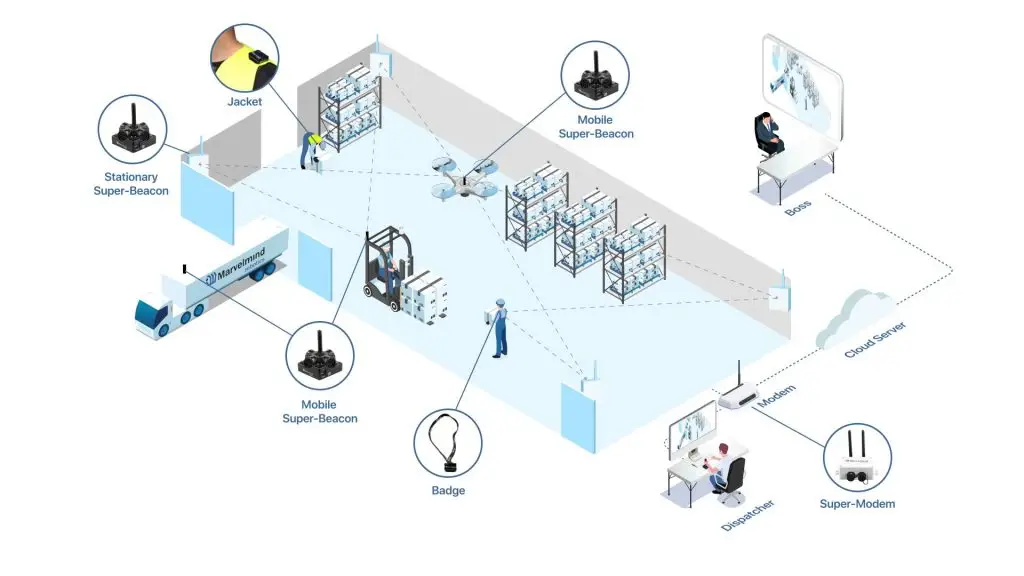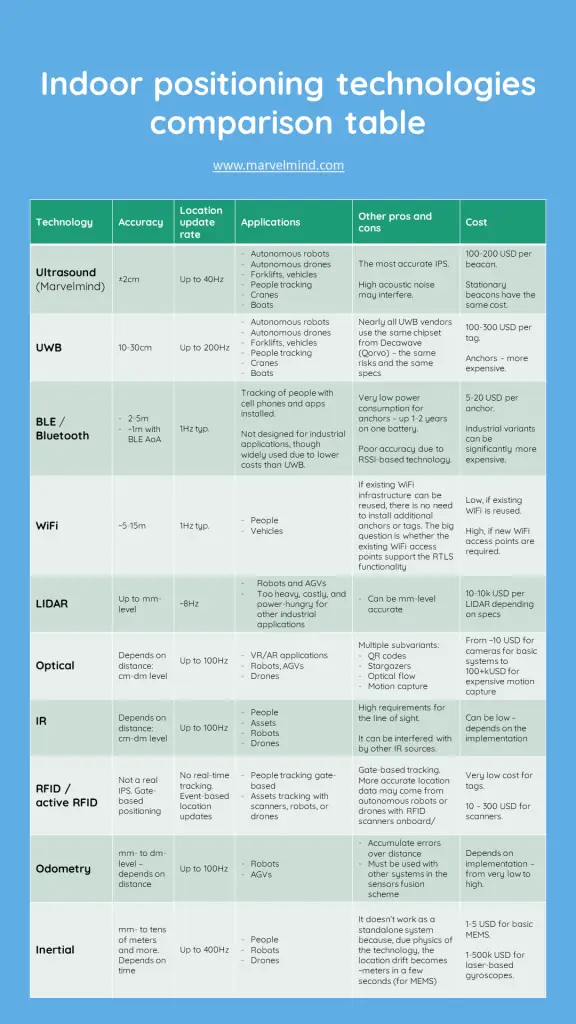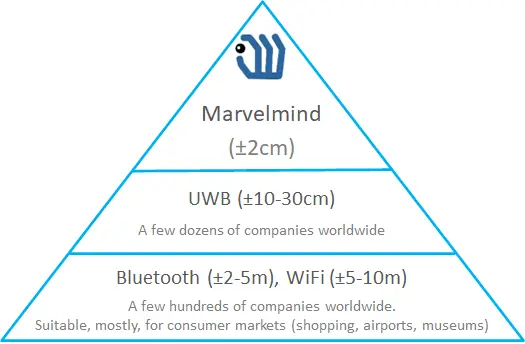How to build indoor positioning system
For autonomous robots, drones, forklifts, cranes, VR/AR, people, and other industrial applications
GPS doesn’t work well indoors, and typical GPS accuracy of 5-10 meters is not enough for industrial applications. Thus, one needs an accurate indoor positioning system (IPS).
Indoor positioning systems are often called real-time locating systems (RTLS) or local positioning systems (LPS). They are practically the same thing if not going into deep details.
Typical applications for indoor positioning systems include autonomous robots, autonomous drones, forklift tracking, other vehicles tracking, crane or hook tracking, VR and AR, people monitoring for safety and productivity, and a long tail of other industrial and scientific applications.
Executive Summary:
In this article, we explain how to efficiently build indoor positioning systems and address the most fundamental questions about indoor positioning systems that managers and engineers have:
It is a deep and broad article focusing on RTLS and IPS for industrial applications. If something important is not covered or even incorrect, please email us at info@marvelmind.com, and we will address it.
- Why do we need indoor positioning systems?
- What is an indoor positioning system (IPS)?
- How does an IPS work?
- What is a real-time locating system (RTLS)?
- What is a local positioning system (LPS)?
- What is Indoor "GPS"?
- What is the best indoor positioning system?
- What is the most accurate indoor positioning system?
- Does GPS work indoor?
- Indoor positioning technologies review
Why do we need indoor positioning systems?

But why not make the radio signal from satellites stronger?… – well, though practically difficult, it is possible. Still, physics would prevent such positioning systems from providing significantly better results since the line of sight is the most fundamental requirement for any precise positioning system.
The typical accuracy of GNSSs – GPS, GLONASS, Galileo, Beidou – for civil applications is 5-10 meters. That is also not enough for indoor applications because tracking accuracy is crucial indoors.
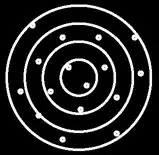
Therefore, we need indoor positioning systems (IPS), often called real-time locating systems (RTLS) or local positioning systems (LPS), with the accuracy of tracking as one of the essential requirements.
What is indoor positioning system?
Indoor positioning system is a network of elements designed to track mobile objects in real time indoor where GNSS (GPS, GLONASS, Galileo, Beidou, etc.) cannot work.
Typical indoor positioning systems consists of the following elements:
Optional elements:
– Simplifies remote control and upgrades of the system
– It is a potential source of sensitive location data leakage
Marvelmind Indoor Positioning System
How does indoor positioning system work?
Indoor positioning systems calculate the positions of mobile beacons (tags) installed on mobile objects (robots, drones, forklifts, people) against stationary beacons (anchors) spread inside the building or other GNSS-denied areas. Most IPSs use either trilateration or triangulation to calculate the location of mobile beacons or objects.
It is worth remembering the vast majority of indoor positioning systems do not track people, robots, or forklifts. They track mobile beacons (tags) installed on them.
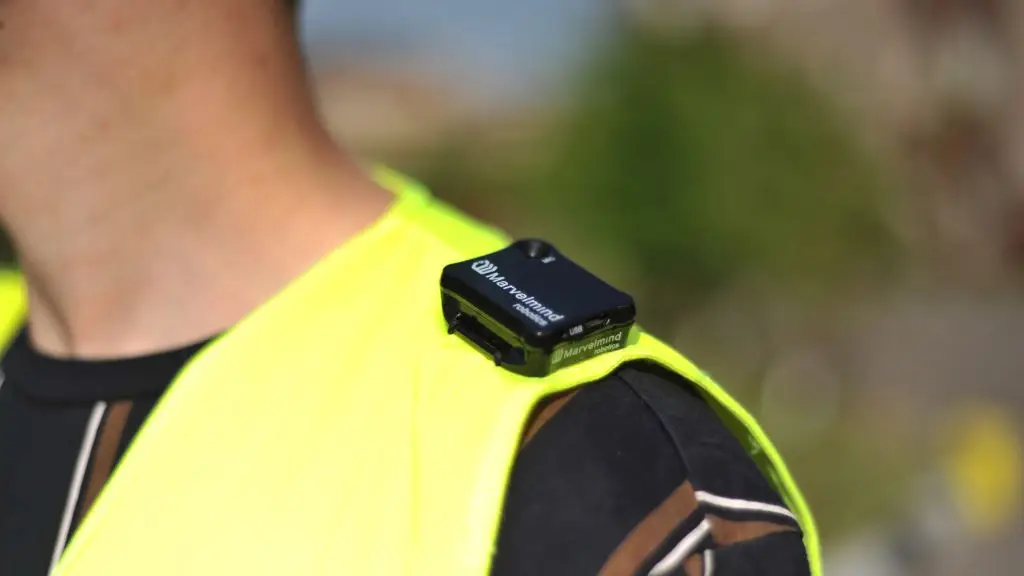
The most accurate indoor positioning systems use time of flight (ToF) and trilateration, for example, Marvelmind Indoor “GPS” or ultra-wideband (UWB). These technologies are the best precise indoor positioning systems for industrial applications.
Very popular though far less accurate BLE systems use RSSI or its flavors, for example, RSSI with AoA.
Optical systems can track objects directly – without placing mobile beacons on them. However, this approach is not without caveats since users of the system need accurate tracking of mobile objects and identification of the objects. With mobile beacons installed on mobile objects (robots, drones, forklifts, people), identification is a trivial task because each mobile beacon has a unique ID. Identification based on optical methods is a complex task that works well only in special conditions that are difficult to meet in the real industrial environment.
What is real-time locating system (RTLS)?
A real-time locating system (RTLS) is a system to localize and track objects in real-time, typically indoors.
Real-time locating system (RTLS) is not necessarily an indoor positioning system. Formally speaking, even GNSS is an RTLS, because it provides location data in real time.
However, historically, RTLS is used nearly universally interchangeably with the term IPS as opposed to clearly outdoor or even open-sky systems such as GNSS.
Thus, in short: Real-time locating system (RTLS) ≈ indoor positioning system (IPS)
What is local positioning system (LPS)?
To confuse users even further, there is a term local positioning system (LPS).
Again, from the practical point of view: RTLS ≈ IPS ≈ LPS.
However, to be picky:
- LPS is not necessarily indoor. Quite the opposite, it is mainly referred to as outdoor
- Usually, LPS is used as an alternative to GNSS, i.e. it is outdoor, but locally – not globally
What is Indoor "GPS"?
We use the term indoor positioning system because we focus on indoor applications. At the same time, we have beacons with ingress protection that also allow working outdoors. In general, there is no architectural difference between indoor and outdoor applications. It is all about environmental conditions: outdoor can be indoor-like, and indoor applications may require Super-Beacons-Outdoor or even Industrial Super-Beacons.
We often refer to our system as RTLS because real-time positioning with a high location update rate and low latency are other crucial parameters of any indoor positioning system, along with its tracking accuracy.
We also call our system Indoor “GPS”. Of course, the system doesn’t rely on GPS satellites as GPS cannot work indoors. Thus, it is “GPS” – not GPS. However, from the end-user point of view, the system acts as a real GPS: there are “GPS satellites” – stationary beacons; there are “GPS terminals” – mobile beacons; there is a “ground station” – modem.
Even more, Marvelmind Indoor “GPS” streams out location data in the native GPS format – NMEA0183. Thus, there is no need for any special integration – GPS-ready systems accept Marvelmind Indoor “GPS” strings of data as a real GPS data stream. Therefore, for the end-users, Marvelmind Indoor “GPS” is seen as a real GPS that works indoors and gives cm-level accuracy instead of the typical 5-10m of GPS.
What is the best indoor positioning system?
What indoor positioning system is the best depends on your requirements and the selection criteria. Nevertheless, here are quick hints:
Download the Indoor positioning technologies comparison table in PDF format.
What is the most accurate indoor positioning system?
Marvelmind Indoor “GPS” is the most accurate commercially available indoor positioning system for industrial applications.
But is it the truth, the whole truth, and nothing but the truth? Well, as usual, the devil is in the details.
Yes, the Marvelmind indoor positioning system is the most accurate IPS among commercially available systems for industrial applications: autonomous drones, autonomous robots, people tracking, forklift tracking, etc.
However, for example, high-quality, expensive LIDARs installed on AGVs with special reflectors installed inside the building can measure the distance with mm-level accuracy. Though distance measurements are crucial for positioning, it is not everything. One needs coordinates – not just distances. Many LIDARs use triangulation for positioning. Because triangulation is used as opposed to trilateration, the positioning accuracy depends on the distance and may become far worse than the mm-level.
Optical tracking systems also use a form of triangulation for positioning. Thus, their accuracy depends on the distance. Therefore, for very short distance – 10-100cm – optical systems can also provide mm-level accuracy of positioning. On the distance of 10-100m, it can easily become 10-100cm.
There are many other – nonindustrial or special applications. Marvelmind Indoor “GPS” can be used for them in many cases. But there could be some niche systems better tuned for the particular tasks.
Does GPS work indoor?
No, GPS does not work indoors. Other GNSS systems such as GLONASS, Galileo, and BeiDou don’t work indoors either because satellite radio signals don’t go through walls and ceilings.
By now, you already have basic understanding of what indoor positioning systems are.
It is time for a deep dive into a detailed indoor positioning technologies review and comparison focusing on industrial applications.
Download our popular detailed review and comparison of different indoor positioning and navigation methods in PDF format.
